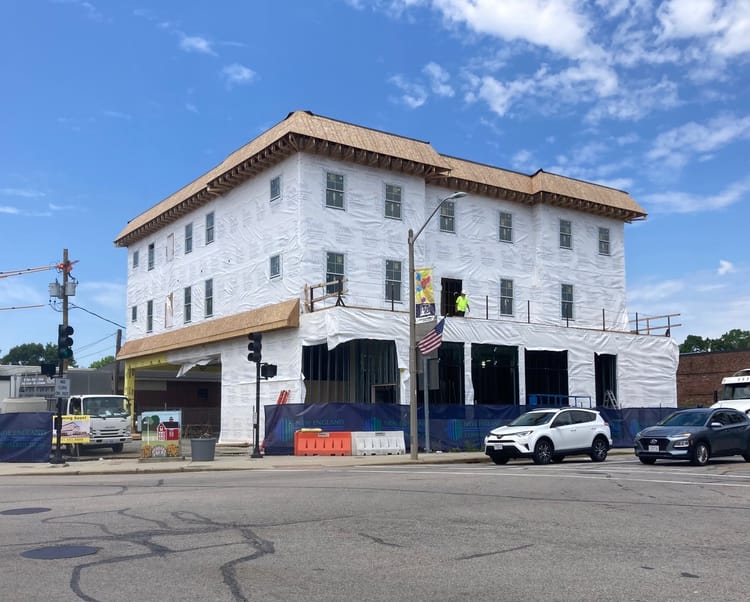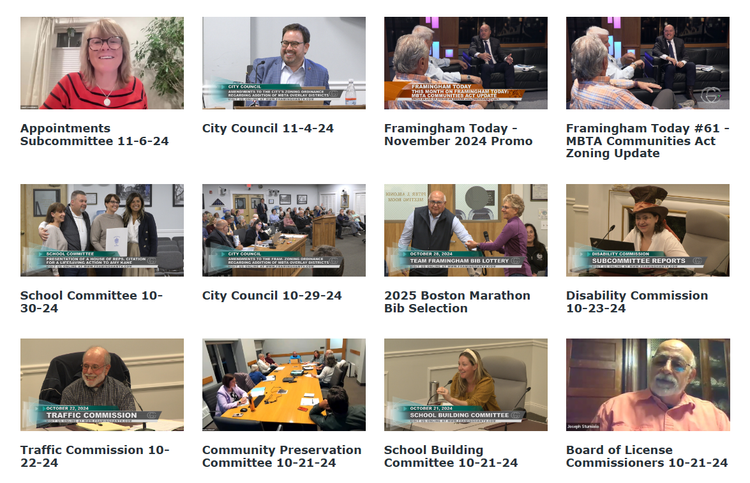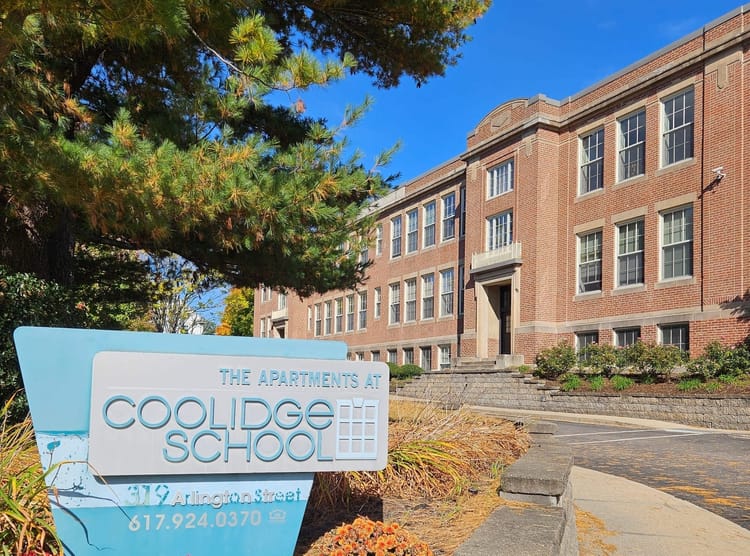Raising the Roof: The promise and politics of higher building heights

Upzone Update offers analysis of MBTA-C compliance efforts, produced by zoning expert Amy Dain and the staff of Boston Indicators. This week's article is by Amy Dain.
This week: a cover article on building heights and lots of news articles and town-by-town updates as a busy fall gets underway!
The importance of building heights
Some people think zoning policy sounds dry. But at its pulsing heart is something that triggers passions: building height limits. Try saying “six stories” at a suburban public hearing about apartment zoning.
Even proposals for four stories animate meetings late into nights, meeting after meeting. Concerns get aired about shadows, loss of small-town sociability and sensibility, and the proportions of places.
But the route to housing sufficiency goes through zoning reform, including to allow taller buildings, in some places. Height means more homes; more projects that pencil; more landowners motivated to take the risk of redevelopment. Especially in historic suburban centers, tall buildings mingle nicely with the short, new with old, fancy with plain. New residents bring new life to Main Street. And shadows can be managed. All to say: it’s worth the grief of heated public argument to suggest six stories.
Boston’s Hancock rises 60 stories. Six stories may seem random, as a conversation-starter for suburban zoning reform. But it is not. For buildings taller than 70 feet, typically six stories, the building code in Massachusetts requires certain fire protection measures that raise building costs by 15 to 20%. In the absence of height limits, suburban “towers” would mostly top off at six stories, the rents and sales of additional stories not justifying the costs. So, there’s a case to be made for not spending political capital in the suburbs on campaigns to zone proactively for, say, eight-story buildings.
Never mind eight stories, few suburbs have been zoning for six-story buildings. For MBTA Communities zoning implementation, the overall trend for the 12 rapid-transit communities (closer to Boston) was to zone for four- or five-story limits. Further out, more communities, like Concord, are capping heights at three stories.

To comply with MBTA Communities, last year Brookline upzoned its wonderful retail spine of Harvard Street, that crosses through Coolidge Corner, for four-story buildings. This past spring, the development firm Oak Hill applied for a permit to build six stories, containing 40 homes above retail, in place of a two-story bank building at 429 Harvard Street. Since the zoning prohibits six stories there, allowing only four, the developer applied for the permit via the state’s Chapter 40B law that allows developers to bypass local zoning, for mixed-income projects, under certain circumstances.
An attorney for the firm reported that the “numbers didn’t crunch” for four stories, due to the current economics of construction. Chapter 40B requires inclusion of more affordable units than the Brookline zoning did, and 40B directly limits profits; that a for-profit developer would choose 40B over the as-of-right permitting option is telling. In any case, Oak Hill withdrew the application in July. It would have been a tough fight for six stories.
At first glance, Malden’s new zoning district for ten-story residential towers looked trailblazing. Unheard of, really. But… the high-rise zoning district covers four parcels only, each currently containing a building taller than ten stories. The district was adopted to meet the state’s requirements under MBTA Communities, but not to allow new ten-story buildings.
Last year, Newton adopted zoning for multi-family housing, limited to 2.5, 3.5, or 4.5 stories, depending on the locations. Some planners have been promoting zoning for “half-stories” also called “plus stories,” or partial stories, in reference to the top floor below the roof. The half-story regulations require either a gable (slanted) roof, or a flat roof set back from the front façade, either way making the floor area of the top story smaller than the lower floors.
The half-story requirements make for interesting rooflines across a neighborhood. From the adjacent sidewalk, the top story may be partly or completely hidden. The half-stories have a PR benefit, like the candy bar that sells for $.99. All the same, at public meetings, opponents of housing density remind everyone, “The half-story is a story! Four and half stories IS five stories.”
“So what, if it looks good and houses people and makes things better?”
Note that height does not hurt people’s experience of Main Street and its side roads. There are so many things more important than building height, like the width of sidewalks, the presence of street trees, the prominence and frequency of front entrances. Zoning for tall buildings can promote all of these things. To gain permission for four to six stories, for example, a property owner could be required to widen the sidewalk to certain dimensions (setting back the building, if needed), plant street trees, and orient entrances to face the public right of way.
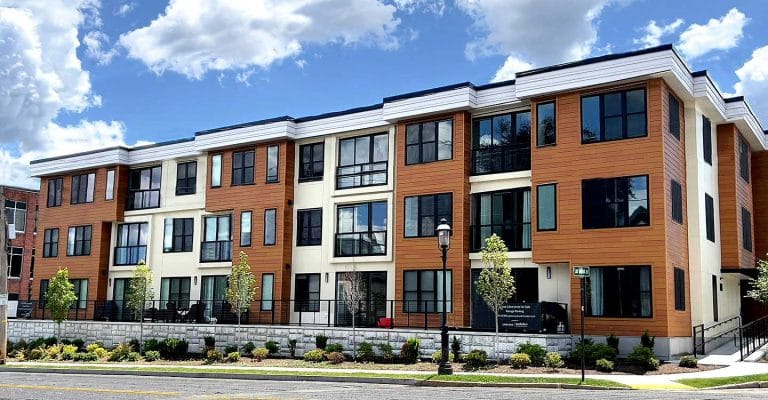
Moreover, locations for six-story permission can be selected based on criteria: A) inconspicuous and B) out of shadow-distance from existing residences. There is a wealth of such parcels in historic centers, between tracks, arterial roads, rivers, highways, and supermarkets or bowling alleys or Walgreens. There are deep properties, where six stories could be allowed in the rear, behind a shorter structure. And large properties, where buildings could step up to six stories towards the center.
Of course, there is an approach to pro-housing zoning reform that doesn’t involve the politics of height, just the politics of single-family-only districts. Last fall, Somerville came into compliance with the MBTA Communities zoning law by legalizing three-unit, three-story multi-family residences across the entire city. Boston Business Journal reports that so far this year, Somerville has received 12 applications for ground-up construction of a three-unit building, and 11 applications to convert a single-family or two-family home to three homes.
The Business Journal summarized, “It was an unusual path toward compliance, but as a city with lots of multifamily already, Somerville did not need to invite giant towers through the rezoning in order to fulfill its mandate.” An unusual path, because it is far easier to win the local votes for tall buildings in commercial and industrial areas than to legalize triple-deckers in single-family neighborhoods. Fortunately, Massachusetts has hundreds of traditional walkable transit-connected amenity-rich commercial centers, well suited for more housing.
Notably, pro-housing leaders in Cambridge are vying to do the unusual as well. Six stories of unusual. Next week, Cambridge City Council will vote on a policy order that would direct city officials to draft a zoning proposal to legalize six stories of multi-family housing – citywide.
Now to the numbers: Homes are on the way!
The first step to gaining more homes is zoning reform; the second step is permitting; the third step construction.
There is exciting news: New housing is getting permitted under MBTA Communities zoning! Here are some of the projects, in various stages.
Bedford: Two projects are in the works: one to replace an existing two-family with a 4-unit building, another to build a 7-unit building in place of a single-family.
Danvers: Danvers has permitted two mixed-use developments including three units and 24 units. There is another six-unit mixed-use project in the pipeline. Prior to adoption of the MBTA Communities-compliant zoning in Danvers, the Town permitted a 145-unit mixed use project in an area that is now a part of the MBTA Communities district. The project is under construction now, due to open next year.
Lexington: Lexington currently has 6 projects totaling 643 units in the formal permitting process, ranging in size from 7 units to 312 units. Additional projects have been informally discussed with staff and neighbors.
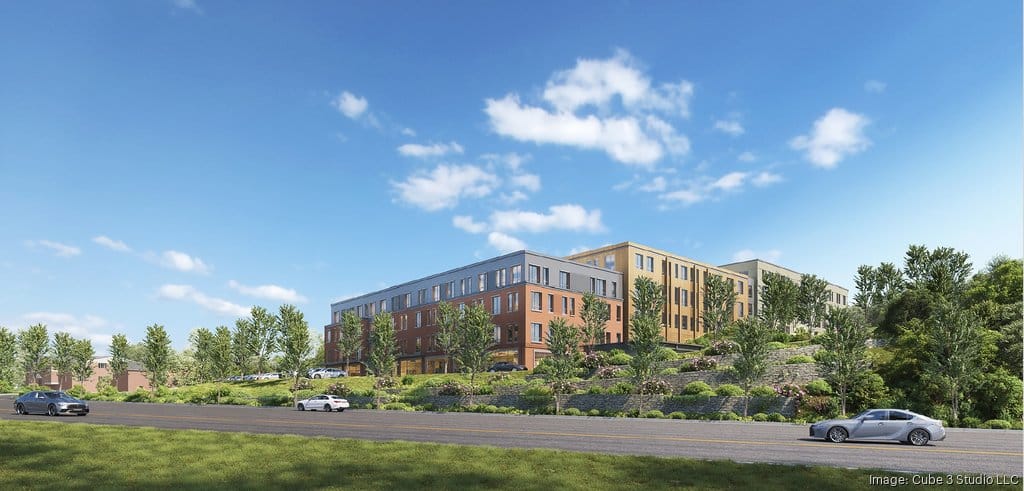
Newton: Two projects are in the permitting pipeline, in the MRT zone, where four-unit buildings are allowed.
Norfolk: A developer is ready to begin the permit application process for 14 units next to the Norfolk train station.
Norwood: Norwood's Planning Board just approved the Site Plan, plus a Special Permit for a density bonus, for a 145-unit project. The bonus awarded an additional floor of building height (for a total of five stories) in exchange for enhanced design for storm-water management and heat island mitigation. The development will replace a former industrial use (chemical cleaner and solvent manufacturing) located directly next to the Norwood Central train station and across the street from a residential neighborhood. It will increase the amount of green space on the existing site.
Somerville: According to this article, Somerville received 12 applications for construction of new three-unit buildings, and 11 applications to add a unit or two to an existing single-family or two-family.
Additional reports: Projects have also been reported to be in the pipelines, in Taunton, Everett, Westford, and Grafton.
The status of community's compliance plans
Upcoming this fall: A lot of votes on MBTA Communities zoning.
There are 177 MBTA Communities total; 74 municipalities have approved zoning to come into compliance with the state zoning law so far.
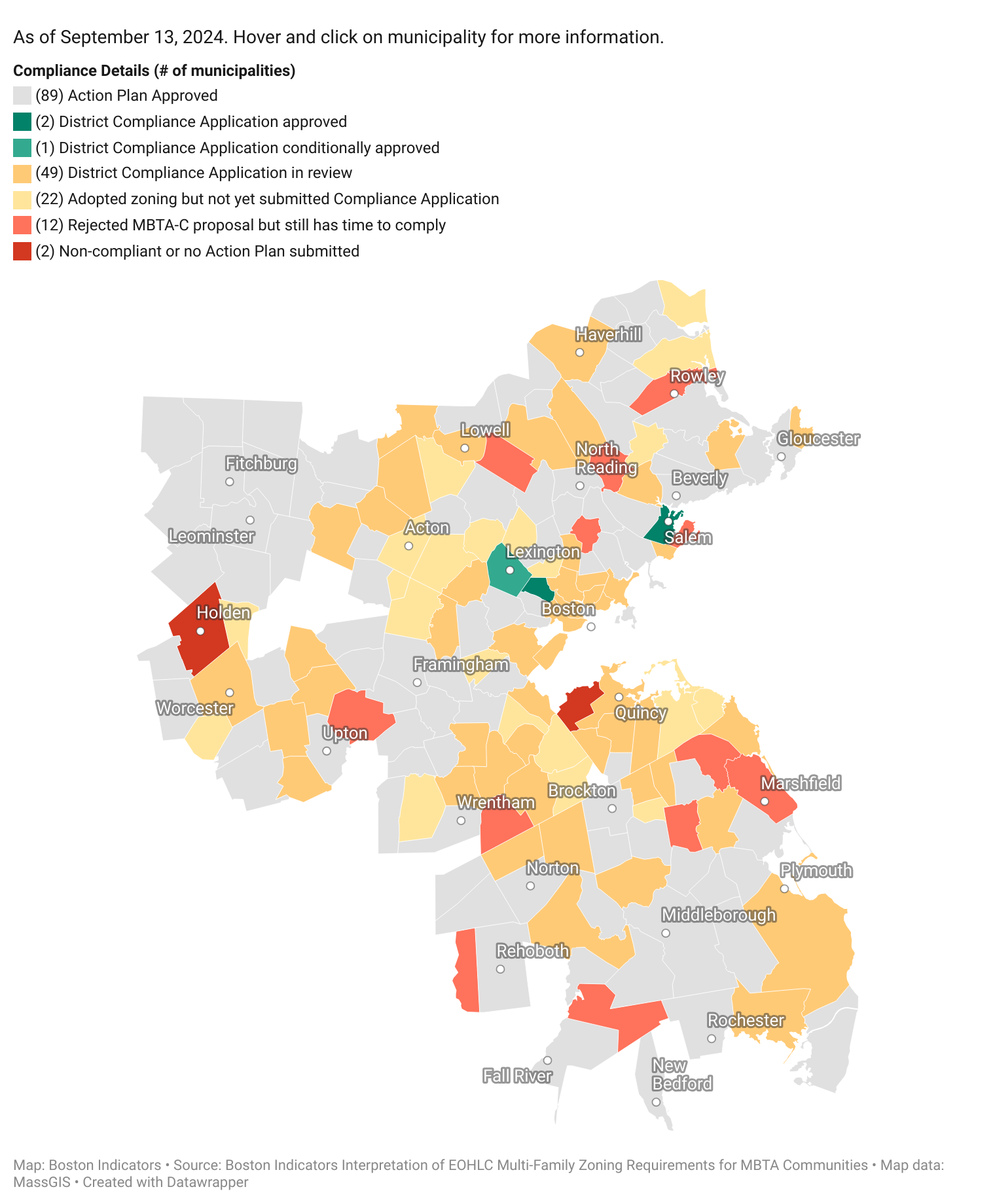
The state set compliance deadlines in three waves. First, the 12 communities served by rapid transit were due to comply by the end of last year. Second, another 130 communities face a deadline of the end of this year. Finally, 35 “small towns” have a deadline at the end of next year (2025).
In the first wave, all 12 passed MBTA Communities zoning, but then Milton overturned its vote via a referendum. In the second wave, so far 59 of the 130 communities have passed zoning to comply. In the third wave, already four of the 35 small towns (Harvard, Newbury, Topsfield, Essex) have passed the zoning.
THIS FALL: The December deadline applies to 130 municipalities. So far 59 of them have passed zoning to comply. Meaning, eyes are on the other 71 this fall! Several communities voted down proposals last spring, and some opted to delay their votes until after the SJC hears the Milton case, which is scheduled for October. Most of the communities are now preparing proposals to be voted on by Town Meeting or City Council.
So far, the state has issued three determinations of compliance, for Arlington, Lexington, and Salem. More determinations are expected soon.
Paperwork: Not all of the municipalities that have approved new zoning have submitted applications for determination of compliance yet. The state is currently reviewing 47 applications for determinations of compliance.
In other news
Important context: Congressman Jake Auchincloss recently concluded that “the cost of housing is the single most important domestic policy issue in America. Full stop.” In her nomination speech, Vice President Kamala Harris declared that “we will end America’s housing shortage.”
If you are reading this far into the Upzone Update, you are likely interested in the Milton case to be heard by the SJC in October. The deadline for filing amicus briefs is September 16. Oral argument is set for October 7. For legal reading, check out the briefs posted at the court website.
CommonWealth Beacon reported on the Milton case in August, explaining “Milton argues the Legislature set out financial penalties for noncompliance and didn’t give Attorney General Andrea Campbell the power to compel compliance through the courts.” The article quotes Campbell: “It is ‘axiomatic’ that a statute’s use of the word ‘shall’ indicates a mandate.”
This summer, Attorney General Campbell reminded communities that compliance with the law is not optional.
Belmont is now considering zoning that includes eight separate subdistricts including one for mandatory mixed-use and one that includes an incentive for mixed-use.
This summer Franklin approved zoning to come into compliance with MBTA Communities.
Ipswich will vote on MBTA Communities zoning at a special town meeting in October. Ipswich’s Select Board voted 3-2 in favor of the zoning proposal. Selectperson Carl Nylen is quoted in the Local News: “The reason laws like this exist is because we as communities have not done enough to encourage housing of all types. I see no proposal by our community, or any others, to change that.”
Foxborough officials have launched a listening tour to build support for zoning reform. Voters at last May's annual town meeting rejected a zoning proposal designed for compliance with MBTA Communities. Some opposed the specific proposal to locate the district on Route 1. Others objected in principle to mandate to rezone. And some advocated that the town wait until a decision is issued in Milton. However, the town meeting is scheduled for November 18, and the final judicial ruling is expected after that.
WGBH reported on homelessness in Worcester County, and mentions MBTA Communities zoning as part of the long term solution to homelessness.
Amesbury adopted a 40R zoning district that works for part of its MBTA Communities zoning obligation.
Officials in Woburn have been working on zoning reform to comply with MBTA Communities.
A developer is applying for a rezoning and special permit in Wellesley for a four-story, 41-unit project, in an area, Walnut Street, also under discussion for MBTA Communities zoning. Wellesley’s Special Town Meeting is scheduled for October 21, at 7:00 pm.
Banker & Tradesman talks cottages, 40R, MBTA Communities, and Amesbury.
Wilmington will take up MBTA Communities zoning, for the second time, at a Special Town Meeting on December 7 at 9:00 am in the High School Auditorium. At the May Town Meeting, the zoning was referred back to the Planning Board.
Natick will take up MBTA Communities at its Fall Annual Town Meeting.
There have been a number of news reports about zoning reform in Rowley. The Zoning Review Committee has been working on a proposal since the town meeting rejected another proposal in May. The committee has been meeting weekly, but the assignment has been challenging.
The state implementation guidelines for MBTA Communities offer significant flexibility for the design of compliant districts. Planners have presented a bunch of different scenarios for Gloucester to reach compliance. After months of discussion, the Planning Board voted 6-0 to recommend a set of zoning changes.
Rockport filed its MBTA Communities zoning plan with the state. Opponents to the plan in Rockport filed a federal lawsuit against the town.
Hopkinton’s Town Meeting, held in May, narrowly rejected the zoning proposal to comply with MBTA Communities. Hopkinton is expected to hold another town meeting in December to take up the issue again. A Zoning Advisory Committee is considering options for zoning reform.
Watertown’s Council approved a plan for Watertown Square. The next step is to approve new zoning for it.
Marblehead’s Fair Housing Committee has been considering strategies for compliance with MBTA Communities, after the town narrowly defeated a proposal in May. Also, some residents have launched a new pro-housing group, the Marblehead Housing Coalition.
Lexington is winning the race to permit homes, under MBTA Communities zoning. The Boston Business Journal has the story.
In Reading, the Community Development Director presented six scenarios for complying with MBTA Communities.
A zoning subcommittee of Wakefield’s Town Council held a forum to gather feedback on ideas for zoning reform. Town Meeting rejected proposals in May.
Middleboro’s Planning Board proposes zoning to comply with MBTA Communities.
Winthrop has been a tough place for zoning reform this year. But, there is a group “Winthrop Working Together,” which supports pro-housing policies.
The Needham Housing Coalition has been working on zoning reform.
A committee in Carlisle has been exploring strategies for compliance.
Many mansions are going up in the suburbs, the Boston Globe reports. The article quotes Michael Yankovski, whose company Saga Partners purchased two parcels recently rezoned in Newton for multi-family housing: “As you start digging into the rules and the regulations, the actual details, it becomes obvious that three units are almost impossible.”
There is so much to say about the new Affordable Homes Act signed into law this summer! More to come on it, in upcoming Upzone Updates. Stay tuned.

